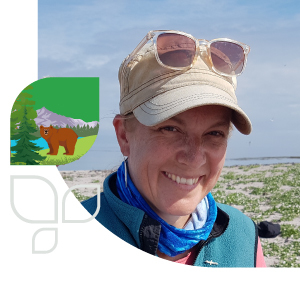Birds, health indicators of our ecosystems
Profile of Jennifer Provencher
Birds, health indicators of our ecosystems

Jennifer Provencher studies the health of ecosystems at Environment and Climate Change Canada. Her work on bird health and her desire to share her research are helping advance knowledge about environmental pollution, including from plastics, wildlife disease, and their impacts on birds. This is the story of a scientist with a stellar reputation.
Focusing on bird health
Jennifer began her career in teaching before exploring the avenue of scientific research. She said, “I was looking for a place where I could do science, collaborate with peers, and raise awareness about different environmental issues.” These aspirations led her to pursue graduate studies in Vancouver, and then Ottawa.
Her master's and doctoral supervisors were at Environment and Climate Change Canada in the Wildlife and Landscape Science Directorate, which allowed Jennifer to integrate into the department naturally. “I feel like I was raised by the Environment and Climate Change Canada community!” she says, clearly happy with her role in the team.
Her early interests focused on the study of seabirds in the Arctic. Jennifer was interested in understanding how climate change and various contaminants impact bird populations. “Our objectives were to study how these changes, and their cumulative effects, affect ecosystems,” she explains. During this period, she gained experience in field research while working with Indigenous communities in the Arctic for several weeks a year.

Having now been with Environment and Climate Change Canada since 2018, Jennifer focuses her activities on two major current subjects of concern: avian influenza virus (AIV) and pollution, including plastic pollution, with the study of birds as the main topic. As a highly skilled scientist, her research focuses on the identification of viruses and pathogens, and the presence of pollution including microplastics in birds' bodies and their eggs. “Animals can have everything they need to live, such as a large territory and food, but still be threatened by health-related problems. This is where my research is focused.” Her team regularly harvests eggs and birds carcass from one end of the country to the other. This Canada-wide research is made possible thanks to the collaboration of various teams within the department, and other partners including Indigenous communities based in the North.
Sharing knowledge
My role is to share the early results, but also to listen to those of my peers to ensure that we push the limits of our knowledge.
Jennifer participates in several collaborative events to share her knowledge with the public and the scientific community. For example, in Ottawa in December 2024, she participated in a high-level panel discussion on plastics science, which brought together dozens of specialists in the field. She explains that “It is vital for research scientists to meet up to exchange our early results, as it can take up to two years for our experiments to be completed and our articles to be available online.”
Encouraging results for birds
In recent years, Jennifer and her team's research have documented some key facts. For instance, at the end of 2021 a highly pathogenic strain of AIV was detected in eastern Canada. It then spread along bird migration routes in North America, leading to a massive seabird mortality rate the following year. Based on her research data from 2023, Jennifer found that a large number of birds that were exposed to the virus had survived. She found that they had developed antibodies over time, which is good news, as it demonstrates their ability to adapt.
Education and public awareness are key to reducing plastic in the environment. I think we’re starting to see that in some areas, we’re starting to see those results, but again, time will tell.
In terms of plastics, plastic pollution is now omnipresent in the environment. Microplastics are found everywhere—in animals, humans, in surface water, drinking water, groundwater, soil, food, and the air. They have also been detected in the stomachs of seabirds, who ingest them involuntarily. Jennifer's team samples plastic in bird stomachs. She reveals that “In general, we find a lower rate of plastic pollution in birds in the Arctic, and a higher rate in those living further south, mapping the influence of southern pollution sources like big cities and urban areas.”
Decisions based on science

Jennifer's important role also contributes to making a difference in government decision-making and the development of policies designed to protect the environment. Part of her work is to measure contamination levels and monitor their trend over time as well as surveillance activities related to the emergence of contaminants of concern, and the emergence or re-emergence of important wildlife diseases. The data collected allows her and her colleagues to assess whether the measures implemented are effective, or whether they need to be modified. “This is how we contribute to a healthy environment for Canadians—by identifying the problems and the solutions that decision-makers should prioritize,” she says. “The results of our work allow us to define the restrictions, or prohibitions, to be applied by environmental policies and to assess whether they are effective.”